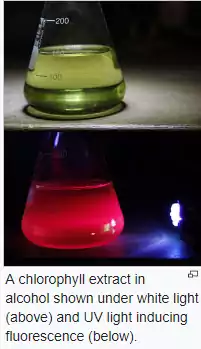
1400 years ago nobody knew that plants emitted light that we cannot see; however it was portrayed it in the Quran.
NASA is studying the emissions of plants from space.
Phys, First-of-its-Kind Fluorescence Map Offers a New View of the World's Land Plants, 2011

Chlorophyll fluorescence became a common method for plant research. This was known recently, however it was portrayed in the Quran 1400 years before it was discovered. In chapter "The Light" olive oil emits light without fire.
Allah is the Light of the heavens and the earth. The allegory of His light is that of a pillar on which is a lamp. The lamp is within a glass. The glass is like a brilliant planet, fueled by a blessed tree, an olive tree, neither eastern nor western. Its oil would almost illuminate, even if no fire has touched it. Light upon Light. Allah guides to His light whomever He wills. Allah thus cites the parables for the people. Allah is cognizant of everything.
٣٥ اللَّهُ نُورُ السَّمَاوَاتِ وَالْأَرْضِ ۚ مَثَلُ نُورِهِ كَمِشْكَاةٍ فِيهَا مِصْبَاحٌ ۖ الْمِصْبَاحُ فِي زُجَاجَةٍ ۖ الزُّجَاجَةُ كَأَنَّهَا كَوْكَبٌ دُرِّيٌّ يُوقَدُ مِنْ شَجَرَةٍ مُبَارَكَةٍ زَيْتُونَةٍ لَا شَرْقِيَّةٍ وَلَا غَرْبِيَّةٍ يَكَادُ زَيْتُهَا يُضِيءُ وَلَوْ لَمْ تَمْسَسْهُ نَارٌ ۚ نُورٌ عَلَىٰ نُورٍ ۗ يَهْدِي اللَّهُ لِنُورِهِ مَنْ يَشَاءُ ۚ وَيَضْرِبُ اللَّهُ الْأَمْثَالَ لِلنَّاسِ ۗ وَاللَّهُ بِكُلِّ شَيْءٍ عَلِيمٌ
"Its oil would almost illuminate, even if no fire has touched it" this is light without fire. Today we know what it is, Chlorophyll fluorescence.
"Light upon light" today we know that we can only see a small part of the spectrum. The rest of the spectrum we cannot see but it is all light.
Extra virgin olive oil turned out to be the most fluorescent of all vegetable oils:
In extra virgin olive oil, out of the three bands only one is attributed to Chlorophyll. This means that its fluorescence is not limited to Chlorophyll. But its Chlorophyll footprint at 681 nm turned out to be the highest of all oils.
In case you don't know how to read charts it says extra virgin olive oil has the highest intensity of all vegetable oils.
HTML Maker